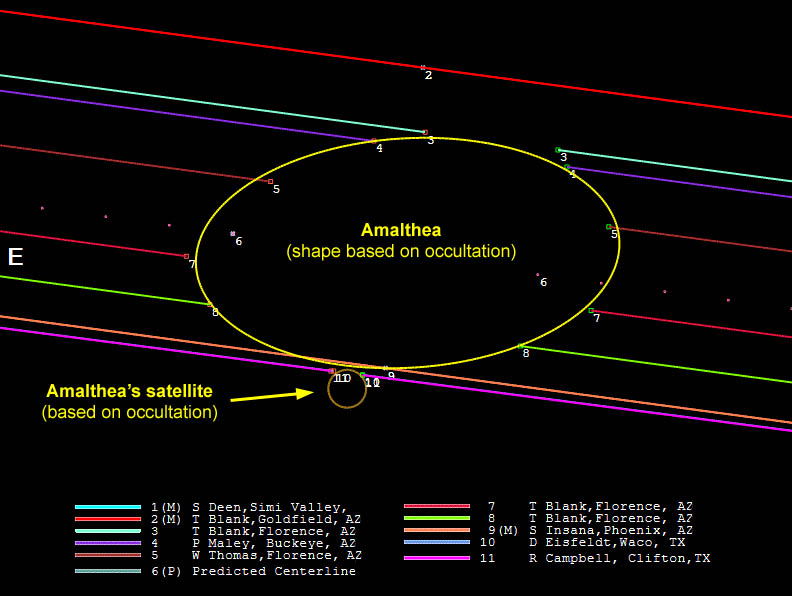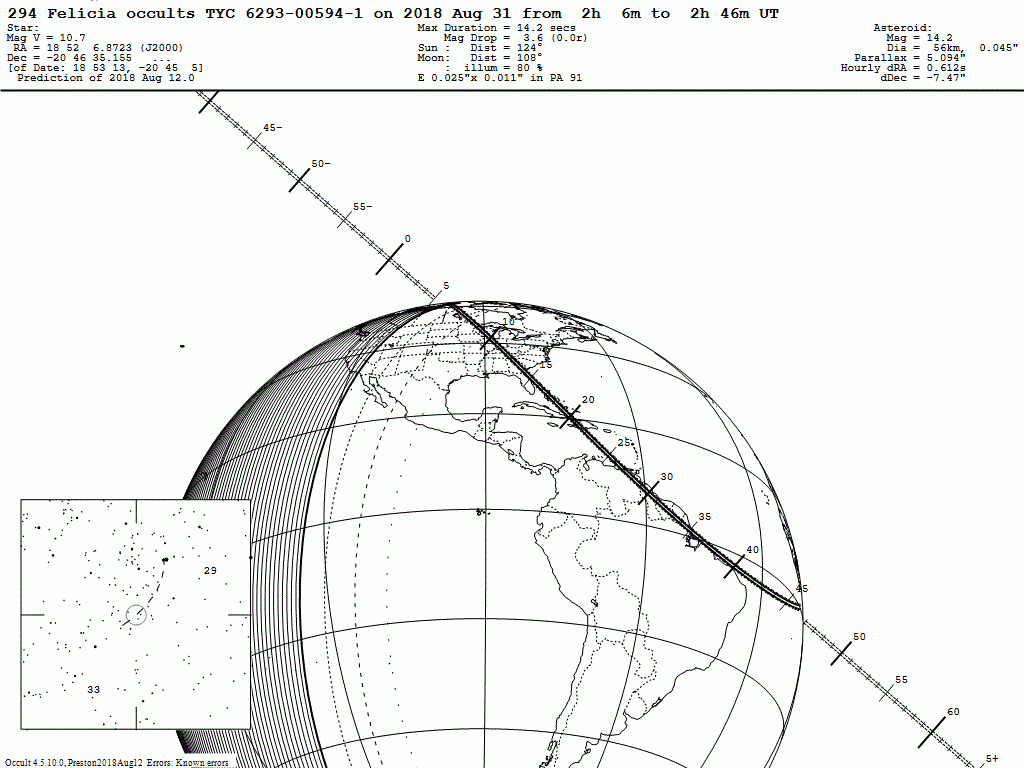As an amateur astronomer, I knew it was only a matter of time before the astronomical community became involved to save WWV. Specifically, it’s a group of mostly amateur astronomers who observe and record occultations.
What’s an occultation? It’s the term when a solar system object passes in front of, and blocks out a star. Why is this important to observe? Lunar occultations are the easiest to observe (if the star is bright enough, one can do a crude observation with binoculars or even the unaided eye). But there is very valuable science to be had with smaller objects. When a dwarf planet [like Pluto] or an asteroid – passes in front of, and “blinks” out or blocks the light of a star – measurements can be taken that reveal the dwarf planet or asteroid’s size/diameter. We can even determine if an object is round/oval – or maybe cigar-shaped when multiple ground observers record and accurately time how long the star “blinks” (or if the star doesn’t get covered by the asteroid in some locations but does in others). Okay, that is Occultations 101 (if you are interested in learning more, see the link).
Credit: Upcoming occultation – showing the path where the occultation is visible – from IOTA: International Occultation Timing Association
Note 1: In 2017, amateur astronomers using a 3” telescope determined that an asteroid had a moon!I had a 3” telescope, back in the 1970s, when I was a kid!
Credit: Sky and Telescope Magazine & IOTA: the International Occultation Timing Association
Equipment used to record and document these fleeting events (some graze occultations only last fractions of a second) requires – you guessed it – time stamped video devices. Back in the old days before video and other advanced equipment, astronomers would sit a shortwave radio next to the telescope with a tape recorder to audibly capture & record the time signal with the observer noting the start/stop of the event (we’ve come a long way since then – time stamped equipment has advanced this from “approximately” to “exact science”!).
The main point of this blog entry: astronomers have been asked to sign the White House petition to maintain NIST stations funding. Sky & Telescope Magazine, if they haven’t already, will be posting an article with an interview that they conducted with one of the leading occultation observers that includes a link to the petition on their web site.
Let’s hope this momentum continues to build – and that it makes a difference!
Guest Post by Troy Riedel.


Good point Laurence … I really should have entitled the post “… save time stations” versus limiting the title to “WWV”.
First off my disclaimer: I am not an expert astronomer … not an expert “amateur”. I tend to dabble in a little bit of everything, with my primary interest being planetary observation (watching surface features change … watching new surface features rotate into view … catching Galilean Satellite Phenomena like one of the four largest moons of Jupiter being occulted by the planet or transit across – in front of – the planet). I am not part of IOTA (per my Post) nor am I a formal member of any occultation observing group (I have sat in their workshops, I’m on their email list, etc., but I’m not necessarily an active member though I have observed occultations).
With that said, what I briefly explained in the Post is the traditional (aka “old”) technic of using a tape recorder – before video was widely used – that I originally learned here (Graze Observer’s Handbook, 1st Ed. 1975 & 2nd Ed. 1979, by Harold R. Provenmire: https://tinyurl.com/y8436zfl). If you go to IOTA’s web site you can download for free a “modern” occultation guide in PDF format.
Personally speaking I have astrophotography equipment, but I do not capture “video” … I do not conduct “video astronomy”. I “stack” multiple stills, maybe hundreds, to produce one image. But I can say this: when I observed the Palma 372 occultation I actually used the “old” technic.
I was privy to an email that previewed the Sky & Telescope Mag. article – or shall I say the email primarily detailed what the expert occultation observer was asked by the Editor of S&T Mag. Essentially – this is from the expert, not me – less and less people are observing & collecting data on occultations now versus the 60s & 70s. Assuming you have a computer and basic equipment, it’s about a $200 outlay to make yourself occultation video capable. But for all of the systems, you need “a time base” and he states, “WWV/WWVH currently provides the least expensive way to robustly provide that.”
For at least double the money, you can purchase GPS time-stamped video equipment. But not everyone has this – and occultation observing is not necessarily the primary activity of many observers who collect data now. Personally speaking, it’s not my primary activity and if I have $500 of disposable income I’ll probably purchase an eyepiece(s) that I can use everyday versus something that I will occasionally use. Remember: these “occultation paths” may be a handful of miles wide and only extend a couple hundred miles. This is very different than everyone in the entire continental U.S. being able to observe the moon at the same time (of course, if the moon is high enough in altitude to be seen across the country at the same time). These occultations are “local” events … having a way that a multitude can collect data on these is the goal.
Another consideration, the band of merry men & women who religiously collect this data are *mobile* … rarely does an occultation pass directly over one’s home observatory (the path might only be a handful of miles wide) – and you need to spread out the observers in different locations because you don’t want everyone in the centerline. You want people to miss it – because that gives you an indication of the size of the asteroid (kind of like a shadow that is cast – there is an edge to the shadow and by knowing the edge you can determine how wide the object is that cast that shadow).
Bottom line: I perceive the fear is that the [potential] loss of WWV/WWVH would limit the number of people who do this, who invest the time to do this. The numbers are already VERY small – and even though the data may not be 100% precise compared with the more expensive equipment, there is never an occultation where everyone is using a “push mower to cut the field”, per se. A smattering of maybe a bit less precise data combined with the more precise data is still very useful and they don’t want to lose that. Yes, there are cell phone apps … Emerald Time … etc., that seem to be decent for visual timing, and I’m sure – even if there are fewer people doing it – the group that continues to collect this data will figure it out as we always do.
Okay, I could go further – sorry for the long reply – but I appreciate everyone who comments. Since I’m nearing the end of my knowledge base on this, I suggest anyone interested in “the rest of the story” search for & check out the S&T Magazine article.
This astronomy topic is a good example that there are much better alternatives to SW time signals: Get a smartphone. Make a video of the occultation. You win two orders of accuracy!
OK: You need to learn to do it the new way. But costs are ninimal.
OK: You might need a camera and an OTG adapter.
I would like to agree before the onslaught. My statements here don’t apply to WWVB, as that is usable by a lot of devices and relevant where a lot of other ways don’t work, but they do apply to WWV and WWVH.
If conditions are bad, WWV/WWVH will not be audible. If you are using it to determine the time, you need to be able to distinguish the signal. Even in the U.S., this is not always an option. Outside the U.S. (and I assume Canada/Mexico), there is usually little chance.
WWV/WWVH require a lot of signal to determine the time. Unlike modern time signals, such as GPS (does not rely on any shortwave systems) and NTP, you can only determine the time by waiting several seconds. An automatic system can use the tones, while a human user can primarily only use the spoken announcements. A system using them would therefore experience trouble if it didn’t have a lot of data. If, for example, I gave you a five-second chunk of data with time data running in the background, GPS and NTP data would allow you to date it, whereas WWV/WWVH would not.
I understand that WWV and WWVH are familiar stations for American swlers. I also can see why WWVB is needed in America given that products exist that require it. However, the usefulness of WWV seems to be over; I somewhat doubt that astronomers are using it anymore. The focus on WWV and WWVH over WWVB makes it seem to me as if the shortwave listeners are interested in mere quantity of broadcasters, rather than importance or real value produced by their signals.
Thank you Thomas. I just hope the blog readers don’t get tired of astronomy invading the SWLing Post Blog 🙂
I like to think that SWLs/BCLs generally have a wider spectrum of interests than the average guy and I suspect many of them are at least curious about astronomy, be it the optical end or some lower portions of the same spectrum. I know I am, and I’m secretly dreaming of my own backyard radio telescope – I just can’t figure out how I could make Arecibo my backyard. 🙂
Even if there’s no interest in astronomy, I think everyone appreciates everything that could help with the NIST funding issue. BTW, WWV was also an important component to make the world’s first but not widely known satellite navigation system (the NNSS, later known as “Transit”) feasible – ground tracking stations needed it as a reference signal against their own oscillators and the satellite signals. It paved the way for the GPS, which is now perceived/misunderstood as rendering the NIST stations obsolete.
Fascinating! Thank you so much for posting this, Troy!